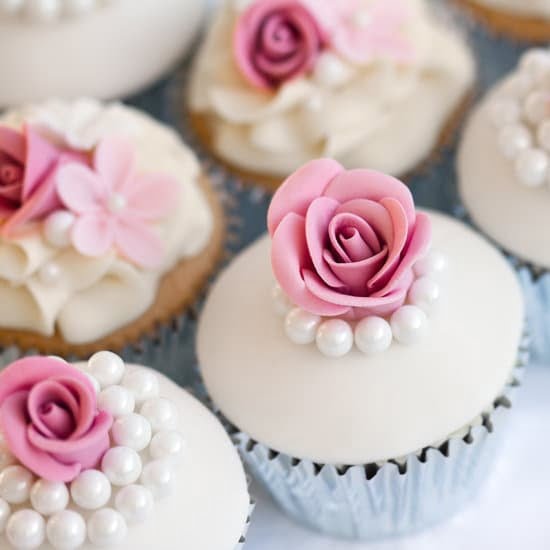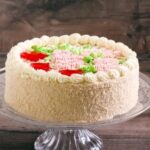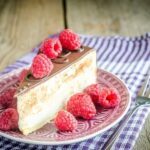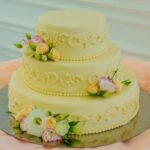Unveiling the beauty and creativity behind various methods of cake decoration, this article delves into the growing popularity and significance of cake decoration in today’s culinary world. From intricate fondant designs to simple yet stunning buttercream creations, cake decoration has become an art form that allows for endless possibilities.
This introductory section aims to set the stage for a journey into the world of cake decoration, where readers can discover and explore different techniques to bring their cakes to life.
In recent years, cake decoration has gained immense recognition as a standalone skill within the realm of culinary arts. Gone are the days when a beautifully decorated cake was limited to special occasions or fancy bakery displays. Today, individuals with a passion for baking and artistry have embraced cake decoration as a means of self-expression and creativity. Whether it is for birthdays, weddings, or other celebrations, the art of decorating cakes has taken on new dimensions.
Throughout this article, readers will be introduced to a wide range of cake decoration methods, each with its own unique style and intricacies. From the elegant mastery of fondant to the simplicity and charm of buttercream, there is something for everyone looking to elevate their cakes from delicious treats to works of edible art. This article aims to inspire bakers and enthusiasts alike by showcasing different techniques and providing helpful tips and tricks along the way.
As we embark on this exploration of cake decoration methods, readers are encouraged to embrace their own artistic abilities and find inspiration in these diverse approaches. So whether you’re a beginner in search of basic piping techniques or an experienced baker ready to tackle 3D sculpted creations, there’s no time like now to dive into the world of cake decoration.
Let your imagination run wild as we venture further into this delectable journey filled with colors, textures, flavors, and endless opportunities for artistic expression.
Fondant
Fondant is a versatile and elegant technique that has become increasingly popular in the world of cake decoration. Its smooth and flawless finish, along with the ability to create intricate designs, make it a favorite among both professional bakers and DIY enthusiasts. Fondant is made from a mixture of sugar, water, and gelatin, which gives it a pliable texture that can be rolled out and draped over cakes for a flawless appearance.
One of the benefits of working with fondant is its versatility. It can be easily colored using food coloring to match any theme or design. Fondant also allows for great creativity as it can be molded into various shapes and forms, making it perfect for creating 3D decorations or covering sculpted cakes. Additionally, fondant acts as a barrier between the cake and the environment, keeping it fresh for longer periods of time.
To achieve flawless designs with fondant, there are a few tips to keep in mind. First, it’s important to knead the fondant thoroughly before rolling it out to ensure that it is smooth and free from lumps.
Using powdered sugar rather than flour when rolling out the fondant will prevent sticking and maintain its texture. When applying the fondant to the cake, start by covering the top and then gradually work your way down the sides while smoothing out any creases or air bubbles.
| Advantages | Disadvantages |
|---|---|
| -Smooth, flawless finish | -Can be expensive |
| -Versatility in shape and design | -May not taste as good as buttercream icing |
| -Longer shelf life | -Requires practice to work with |
Buttercream
When it comes to cake decoration, buttercream is a classic choice that never goes out of style. With its smooth and creamy texture, buttercream allows for endless possibilities in creating stunning designs on cakes. Whether you’re a professional baker or just starting out, buttercream decoration techniques are accessible and can be easily learned.
One of the most popular buttercream techniques is piping, which involves using a pastry bag and various tips to create intricate designs on the cake’s surface. The possibilities with piping are virtually endless, from basic borders and swirls to more extravagant floral patterns and intricate details. Here are some common piping techniques used in buttercream cake decoration:
- Borders: A simple but effective way to enhance the edges of your cake is by adding borders using different piping tips. Common border styles include shell, bead, reverse shell, and rope borders.
- Swirls: Creating beautiful swirls on a cake is easy with buttercream. Using a star or round tip, pipe circular motions from the center outward to achieve elegant swirls that cover the entire surface of the cake.
- Rosettes: Add a touch of elegance by incorporating rosettes into your design. Start in the center and pipe small circular motions outward in a spiral pattern to create stunning rosettes that can be placed individually or grouped together for added impact.
- Drop Flowers: For a delicate and whimsical touch, try making drop flowers with buttercream. Using a petal tip, pipe five or six petals around a central dot to create lovely flower shapes.
In addition to these techniques, stenciling, combing effects, and ombre designs can also be achieved using buttercream icing. The versatility of this medium allows decorators to experiment with different colors, textures, and designs for truly unique creations.
Buttercream offers not only stunning aesthetics but also an indulgent taste that complements any cake flavor. It’s also a forgiving medium, making it ideal for beginners who want to try their hand at cake decoration. So whether you’re creating a simple birthday cake or an elaborate wedding masterpiece, buttercream is sure to elevate your creations to new heights.
Remember, practice makes perfect when it comes to buttercream decoration. Don’t be afraid to experiment and try out different techniques until you find your own signature style. With buttercream, even the simplest designs can turn into jaw-dropping works of art that will impress any crowd.
Royal Icing
Delving into the classic art of royal icing for cake decoration, perfect for special occasions. Royal icing is a versatile and elegant technique that has been used for centuries to adorn cakes with intricate designs. Its smooth texture and ability to hold its shape make it an ideal medium for creating stunning decorations.
The process of working with royal icing involves skillful piping and intricate designs, giving cakes a touch of traditional elegance. The icing is made by combining powdered sugar with egg whites or meringue powder, resulting in a thick and glossy consistency that can be piped onto cakes using various tools such as piping bags and nozzles.
One key benefit of using royal icing is its ability to dry hard, allowing the decorations to be handled and stored without smudging or losing their shape. This makes it perfect for creating elaborate designs that require precision and detail. Whether it’s delicate lacework, intricate flowers, or personalized messages, royal icing offers endless possibilities for cake decorators.
To achieve flawless royal icing designs, proper technique and practice are essential. Beginners can start by mastering basic piping techniques such as dots, lines, and scrolls before progressing to more complex patterns. It’s important to have a steady hand and control the pressure exerted on the piping bag to create consistent lines and shapes.
Using different piping tips can also add variety to royal icing designs. From small round tips for outlining details to large star-shaped tips for filling larger areas, decorators can experiment with different textures and effects. Mixing different colors of royal icing allows for more creative possibilities, enabling decorators to achieve vibrant designs or subtle shades.
Edible Flowers and Fruits
Edible Flowers: Blooming Beauty on Cakes
One of the latest trends in cake decoration is the use of edible flowers to add a touch of natural beauty. Edible flowers not only enhance the visual appeal of cakes but also provide a unique and refreshing flavor profile. From delicate rose petals to vibrant marigolds, there is a wide range of edible flowers available that can be used creatively to adorn your cakes.
Selecting Edible Flowers for Cake Decoration
When choosing edible flowers for cake decoration, it is essential to ensure that the flowers are safe for consumption. Some popular options include pansies, violets, lavender, chamomile, and calendula. It is important to source these flowers from reputable suppliers or ensure that they have been grown organically without any exposure to pesticides or chemicals.
Preparing and Arranging Edible Flowers
Before using edible flowers on cakes, it is crucial to clean them properly by gently washing them and removing any dirt or bugs. It’s also advisable to remove the pistils and stamens from larger flowers as they may have a bitter taste or cause allergies in some individuals. Once cleaned, the flowers can be arranged on cakes in various ways such as scattered petals, flower crowns, or even creating elaborate floral designs.
Incorporating Fruits into Cake Decoration
In addition to edible flowers, fruits can also be used as a beautiful and delicious addition to cake decoration. From fresh berries to sliced citrus fruits, incorporating fruits into cake designs adds color, texture, and freshness. Fruits not only look appealing but also offer a burst of flavor that complements the sweetness of the cake.
Choosing Fruits for Cake Decoration
When selecting fruits for cake decoration, it’s important to choose ones that are firm and ripe but not overly soft or mushy. Popular choices include strawberries, blueberries, raspberries, kiwis, oranges, and pineapples. It’s best to select fruits that are in season, as they will be more flavorful and vibrant.
Arranging Fruits on Cakes
There are numerous ways to arrange fruits on cakes, depending on the design you wish to achieve. For a simple and elegant look, you can place fresh berries or sliced fruit on top of a buttercream or cream cheese frosting. Alternatively, you can create intricate patterns by carefully arranging fruit slices in concentric circles or even creating cascades of fruit down the sides of the cake.
By incorporating edible flowers and fruits into cake decoration, you not only elevate the visual appeal of your creations but also infuse them with natural flavors and textures. Get creative and experiment with different combinations to bring nature’s art onto your cakes.
3D Sculpted Cakes
Stepping into the realm of sculpted cakes opens up a world of creativity and imagination. These whimsical creations transcend the traditional shape of a cake, allowing bakers to bring their wildest dreams to life in edible form. Whether it’s a realistic replica of an object or a fantastical creature, 3D sculpted cakes are sure to captivate and amaze.
Designing and carving a 3D cake requires careful planning and precision. Bakers start with a rough sketch or blueprint of the desired design, ensuring that all proportions are accurate. From there, they sculpt the cake using various techniques such as carving, stacking, and layering to achieve the desired shape. It’s important to work with firm and chilled cake layers to maintain stability during the carving process.
Once the basic shape is achieved, it’s time to bring the sculpture to life with intricate decorating techniques. This is where the real magic happens. Bakers use fondant or buttercream to add details such as textures, colors, and fine lines. From scales on a dragon to petals on a flower, these details require steady hands and patience.
Some popular designs for 3D sculpted cakes include characters from movies or TV shows, animals, sports equipment, vehicles, or even landmarks. The possibilities are endless when it comes to creating these whimsical wonders. If you’re feeling adventurous in your cake decoration journey and want to make an unforgettable statement at your next celebration, consider trying your hand at 3D sculpted cakes.
In summary, 3D sculpted cakes take cake decoration to new heights by transforming ordinary desserts into extraordinary creations. With careful planning in designing and carving the cake and meticulous attention to detail during decorating, bakers can create edible works of art that leave lasting impressions. So let your creativity soar and embark on this whimsical journey by adding 3D sculpted cakes to your repertoire of cake decoration methods.
Airbrushing
Airbrushing is a vibrant and versatile technique used for cake decoration that creates stunning gradients, shadows, and intricate designs. This method involves using an airbrush tool that sprays food-safe colors onto the cake surface. The result is a professional-looking finish that adds a touch of artistry and vibrancy to any cake.
Techniques and Tools
There are several techniques when it comes to airbrushing cakes. One of the most common techniques is creating gradients or ombre effects by blending different shades of colors together. This technique can be achieved by starting with the lightest color and gradually adding layers of darker shades until the desired gradient effect is achieved.
Another popular technique is creating shadow and dimension on cakes. By strategically spraying darker shades along edges or specific areas of the cake, depth is created, making elements appear more realistic or three-dimensional.
To achieve stunning airbrushed designs, various tools are used alongside the airbrush itself. Stencils can be utilized to create intricate patterns or images on the cake surface. These stencils are placed on top of the cake, and then the desired colors are sprayed over them to transfer the design onto the cake.
Similarly, masking techniques can also be employed to create clean lines or block off certain areas for specific color applications. Items such as tape or cut-outs can act as masks, allowing for precise and controlled airbrushing.
Tips for Achieving Stunning Results
When it comes to airbrushing cakes, there are a few tips that can help ensure flawless results:
- Practice makes perfect: Airbrushing takes practice to master, so start by experimenting on smaller projects before moving on to larger cakes.
- Begin with light colors: Start with lighter colors when layering to avoid overpowering the design with too much dark pigment.
- Control your hand movements: Maintain a consistent distance from the cake surface and keep your hand motions fluid to achieve even coverage.
- Take breaks between layers: Allow each layer of color to dry before applying the next to prevent smudging or bleeding.
- Protect surrounding areas: When airbrushing, cover any parts of the cake you do not want to be sprayed with plastic wrap or parchment paper.
Airbrushing is an exciting and creative method of cake decoration that allows for endless possibilities. From creating realistic gradients to adding intricate designs, this technique adds a splash of vibrancy to cakes. With practice and experimentation, anyone can master the art of airbrushing and create stunning edible masterpieces.
Piping Techniques
Piping techniques have long been a staple in cake decoration, allowing bakers to create intricate and stunning designs on their cakes. From basic borders and lettering to extravagant and elaborate patterns, piping offers endless possibilities for creativity. By using different piping tips and techniques, cake decorators can achieve various textures, shapes, and designs, showcasing their artistry in the world of confectionery.
One of the most basic piping techniques is creating borders or outlines on cakes. This involves using a round tip to pipe a continuous line of buttercream or royal icing around the edges of the cake. It adds structure and definition to the cake design, whether it’s a simple single border or an ornate pattern made up of multiple layers.
For those looking to take their piping skills to the next level, there are more advanced techniques like ruffles, petals, rosettes, and basketweave. Ruffles create soft waves that add movement and elegance to any design. Petals can be piped individually or layered together to create beautiful flower decorations. Rosettes are perfect for adding dimension and texture with their swirls of buttercream or royal icing. Basketweave involves weaving thin strands of icing in an interlocking pattern, resembling a woven basket.
The beauty of piping lies in its versatility – it can be used not only for decorative purposes but also for writing messages or personalizing cakes with names and special wishes. Piping allows for precise control over the flow of icing, enabling bakers to create intricate details that make each cake a unique work of edible art.
Whether you’re a beginner just starting out with piping or an experienced decorator looking to challenge yourself with extravagant designs, there is no limit to what you can achieve with this versatile technique. So grab your piping bags, experiment with different tips and icing consistencies, and let your creativity flow as you explore the world of piping in cake decoration.
Brush Embroidery
Brush embroidery is a delicate and artistic technique that adds an exquisite flourish to cake decoration. This method involves creating intricate floral designs using fine brushes and edible paints, resulting in a beautiful embroidered effect on the cake. Brush embroidery is often used to create stunning floral arrangements, adding a touch of elegance and sophistication to any cake.
To achieve the brush embroidery effect, a smooth layer of buttercream or fondant is applied to the cake. Once the base is prepared, different shades of edible paint are mixed and loaded onto a fine brush. The brush is then lightly dragged across the surface of the cake, creating delicate strokes that mimic the appearance of embroidery thread.
One of the key benefits of brush embroidery is its versatility. It can be done on both buttercream and fondant cakes, allowing bakers to experiment with different mediums and textures. Brush embroidery can also be used to accentuate specific areas of the cake or cover larger sections for a bold statement. With practice, bakers can create intricate details such as overlapping petals, textured leaves, and even lifelike flowers.
To create stunning brush embroidery designs, it’s essential to have precision and patience. Fine-tipped brushes are recommended for creating intricate details, while broader brushes can be used for filling larger areas with color. Bakers should take their time when applying each stroke to ensure clean lines and smooth transitions between different colors.
Whether you’re aiming for a vintage-inspired design or want to add an elegant touch to your cake, brush embroidery offers endless possibilities for artistic expression. By mastering this technique, bakers can elevate their cakes from ordinary desserts to extraordinary works of art that are sure to impress both visually and in taste. So why not pick up your brushes and start exploring this exquisite method of cake decoration?
Conclusion
In conclusion, the art of cake decoration is a vast and exciting world, filled with endless possibilities and opportunities for creativity. Throughout this article, we have explored various methods of cake decoration, from the versatile fondant technique to the simplicity and charm of buttercream.
We have also delved into the classic elegance of royal icing, the natural beauty of edible flowers and fruits, the whimsical wonderland of 3D sculpted cakes, the vibrant world of airbrushing, the intricate designs achievable with piping techniques, and the delicate artistry of brush embroidery.
Each method offers its own unique appeal and allows for different styles and designs to be achieved. Whether you prefer working with fondant to create elegant masterpieces or enjoy using buttercream to create stunning yet simple designs, there is a cake decoration method that will suit your preferences and skills.
As you embark on your journey into the world of cake decoration, we encourage you to experiment with different methods and techniques. Let your creativity soar as you explore different tools, colors, textures, and flavors. The key is to find your preferred cake decoration method that brings joy and satisfaction in bringing your creations to life.
So grab your piping bags and brushes or roll out that fondant – let’s get started on creating beautiful works of edible art. Happy decorating.
Frequently Asked Questions
What are the seven 7 main types of decorations for pastries?
The seven main types of decorations for pastries are icing or frosting, fondant, piping, sprinkles or sugar crystals, edible flowers, chocolate ganache, and fruit or nut garnishes. Icing or frosting is a classic decoration that comes in various colors and can be spread or piped onto the pastry. Fondant is a smooth and pliable icing that can be rolled out and draped over cakes to create a flawless finish. Piping involves using a pastry bag to create intricate designs with buttercream or royal icing.
Sprinkles or sugar crystals are small colorful particles that can add texture and visual appeal to the pastries. Edible flowers not only provide a beautiful aesthetic but also impart a unique flavor to the desserts. Chocolate ganache is a rich and glossy glaze made from chocolate and cream that can be poured over cakes or used for decoration. Lastly, fruit or nut garnishes are fresh fruits, berries, or chopped nuts that can complement the flavors of the pastries while also adding visual interest.
What is the best way to decorate a cake?
The best way to decorate a cake depends on personal preference and the desired outcome. However, there are some general tips that can help achieve beautiful results. First, it’s essential to ensure that the cake layers are leveled and properly cooled before starting to decorate. This will ensure that the decorations adhere well and don’t slide off due to warmth.
It’s advisable to crumb coat the cake first by applying a thin layer of frosting all over it before proceeding with the final decoration. This helps seal in any loose crumbs and provides a smooth base for further embellishments. Using tools like spatulas and offset spatulas can help achieve clean edges and smooth surfaces while spreading frosting or fondant. Decorating tips for piping bags come in various shapes and sizes, allowing for versatile designs on cakes with different textures.
What are the three essentials of cake decorating?
The three essentials of cake decorating are proper planning/design, good quality ingredients/tools, practice/experience. Proper planning and design involve deciding on the theme, color scheme, and overall aesthetics of the cake. It’s crucial to visualize the end result and have a clear idea before starting the decoration process. Good quality ingredients, such as fresh buttercream or high-grade fondant, along with reliable tools like piping bags, spatulas, and cutters play a vital role in achieving professional-looking results.
Investing in good equipment will ensure that the decorations are precise and enable easy execution of design ideas. Lastly, practice and experience are key to becoming proficient in cake decorating. Trying out different techniques, experimenting with new designs, and learning from mistakes can help improve skills over time. It’s essential to keep practicing and not be discouraged by initial setbacks as cake decorating is an art that requires patience and perseverance to master.

Welcome to our cake decorating blog! My name is Destiny Flores, and I am the proud owner of a cake decorating business named Cake Karma. Our mission is to provide delicious, beautiful cakes for all occasions. We specialize in creating custom cakes that are tailored specifically to each customer’s individual needs and tastes.





